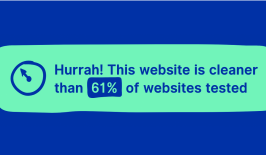A new study takes a look at the power consumption and CO2 emissions caused by the very backbone of the internet – data centres – and offers ideas on what we can do to ensure that this cornerstone of our digital lives is greener and kinder to the planet.
There are all kinds of smart, digital solutions that can help us create a more sustainable world – by helping us to save energy for example, to conserve resources or to protect wildlife. The RESET.org blog is full of examples.
Simon Hinterholzer and Ralph Hintemann from the Borderstep Institute, authors of the short study “Data Centres in Europe – Opportunities for Sustainable Digitalization” (in German: “Rechenzentren in Europa – Chancen für eine nachhaltige Digitalisierung”) published at the end of May 2020, agree with us, stating that:
“A powerful, resilient and sustainable digital infrastructure promotes sustainable industrialisation and supports innovation.”
The coronavirus pandemic has also shown us that digital infrastructures could play a crucial role in protecting the climate in the future. In recent months, road and air traffic has massively been reduced, slashing greenhouse gas emissions – with more and more people staying at home and relying on digital tools to work, shop and carry out their day to day lives.
Hand in hand with this, of course, comes a huge increase in the amount of data being sent and received around the world. As a study by the Wuppertal Institute and Ernst & Young (EY) commissioned by the German Federal Ministry for the Environment shows, data traffic has increased by around ten percent during the coronavirus crisis – and set new records: on March 10th 2020, a new world record for data throughput was recorded – 9.16 Tbit/s, equivalent to 2 million HD videos or 2 billion A4 pages of text being transmitted per second.
But while all that data might seem invisible to us, it leaves a very real mark: With all of our video conferencing and streaming, we’re chasing thousands of bits and bytes through the world wide web – and transporting that data requires a physical infrastructure in the form of networks, servers, data centres and all of our end devices – computers, smartphones and more.
In their study, Hintemann and Hinterholzer take a look at the environmental impacts of data centres and provide new information about the future development of energy efficiency, energy requirements and greenhouse gas emissions from data centres in Europe. In their analysis, they look at a wide range of different kinds of data centres: from server rooms in small and medium-sized companies, to colocation data centres, supercomputers used in research and development and hyperscale data centres using cloud and big data storage. Specially-built computing systems, which have been developed for cryptocurrency mining, for example, or artificial intelligence applications, are also included in their analysis.
Hintemann and Hinterholzer state that the global performance of data centres has increased by a factor of ten in the past decade, while the amount of data transmitted worldwide has increased by almost a factor of 20. Because the energy efficiency of the data centres has improved significantly over the same period, the strong increase in performance is actually paired with only a moderate increase in the energy requirements of European data centres – between 2010 and 2020, the energy requirements rose from 56 terawatt hours to 87 terawatt hours (a 55 percent increase). This means that data centres currently use around 2.7 percent of the electrical power in Europe.
Future forecasts predict a further increase in energy consumption to 98 terawatt hours by 2030. Analysis also shows that investments in energy-efficient data centre infrastructure in the past decade have led to a significant decrease in the energy consumption of the technical equipment needed to keep data centres ticking over – like cooling systems, the power supply and fire protection equipment. According to the authors, this is a sustainable and positive effect. And it shows two things: rapid digitalisation can consume huge amounts of resources, but it can also be used to make our growing demand for data more sustainable.
The Bottleneck of Sustainable Digitalisation
The power consumption of data centres is one of the main sources of the CO2 emissions caused by our digital world, otherwise known as our Digital Carbon Footprint. The direct environmental impact that data centres have depends on the electrical energy required to operate them and the CO2 emissions that this may cause. So not just the electricity consumption, but also the type of electricity that data centres consume is incredibly important when it comes to their climate impact. Many data centre operators are already improving their carbon footprint by increasing their use of renewables. According to the report, “30 percent of the data centre operators surveyed in Germany in 2017 stated that their data centres are powered entirely by renewable energies.”
When you take a look at specific emissions, however, there is a lot of difference between individual European countries, with the local electricity mix (how much comes from renewables, how much from coal and oil, etc) having a big impact on data centres’ CO2 emissions.
However, the EU’s goal is to have a 32% share of renewable energies by 2030 (European Commission, 2020). If this happens, emissions will decrease by 30 percent in the coming decade alone and individual states will reduce the CO2 emissions they produce from electricity generation. In Germany, it is predicted that CO2 emissions from electricity generation will only decrease slowly. This is mainly due to the fact that the country plans to withdraw very slowly from coal-based electricity generation – aiming to be coal-free by 2035 or 2038 at the earliest.
Data centres are the digital backbone of sustainable new technologies
According to the authors, when taking a look at the life cycle assessment of data centres it’s not just about considering their CO2 emissions, but also their positive effects:
“Data centres and broadband networks are (…) also a key prerequisite for ecologically sustainable digitalisation in Europe. When it comes to achieving the climate targets in Germany and Europe, they can play a significant role.”
In particular, digitalisation has huge potential when it comes to reducing greenhouse gas emissions. According to various studies, this potential could be “three to ten times higher than the greenhouse gas emissions that arise directly from the operation of digital devices and infrastructures”. This is because digital technologies could enable us to implement economic processes in a more resource-efficient way, efficiently control traffic flows, encouraging the take up of affordable and clean energy or enabling more sustainable consumption and production.
According to the authors, if digitalisation in Europe is to be sustainable and competitive, digital infrastructures and data centres need to be integrated into an overall energy industry concept in the future – where they’re powered by renewable energies and the waste heat they emit is sustainably reused.
It can currently be assumed that artificial intelligence in particular will be applied much more often in many different areas. However, programming the algorithms required often demands a lot of computer power – and subsequently a lot of energy too. And when it comes to autonomous vehicles, Industry 4.0 and smart cities, a multitude of new applications are expected that require high data centre performance.
As the authors stress:
“Public discussions and regulatory measures around climate protection can also have a significant impact on the future development of digital infrastructures in Europe, especially the European Commission’s goal to be operating data centres and telecommunications networks in a climate-neutral way by 2030”.
The second part of the study will follow in autumn 2020, offering concrete case studies on energy- and resource-efficient data centres in Europe as well as opportunities and challenges that may arise from regulatory frameworks and the use of waste heat.This is a translation by Marisa Pettit of an original article that first appeared on RESET’s German-language site.






